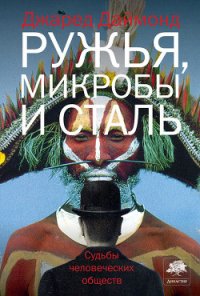Коллапс - Даймонд Джаред (читать книги бесплатно .txt) 📗
Два самых значительных обзора археологических работ по норвежским гренландцам за последние 20 лет: Thomas McGovern. «The Vinland adventure: a North Atlantic perspective» // North American Archaeologist 2:285–308. 1981;Thomas McGovern. «Contributions to the paleoeconomy of Norse Greenland» // Acta Archaeologica 54:73-122. 1985;Thomas McGovern et al. «Northern islands, human era, and environmental degradation: a view of social and ecological change in the medieval North Atlantic» // Human Ecology 16:225–270. 1988;Thomas McGovern. «Climate, correlation, and causation in Norse Greenland» // Arctic Anthropology 28:77-100. 1991; Thomas McGovern et al. «А vertebrate zooarchaeology of Sandnes V51: economic change at a chieftain's farm in West Greenland» // Arctic Anthropology 33:94-121. 1996;Thomas Amorosi et al, «Raidingthe landscape: human impact from the Scandinavian North Atlantic» // Human Ecology 25:491–518. 1997;Tom Amorosi et al. «They did not live by grass alone: the politics and paleoecology of animal fodder in the North Atlantic region» / /Environmental Archaeology 1:41–54. 1998. Были использованы следующие материалы Арнеборга: Jette Arneborg. «The Roman church in Norse Greenland» // Acta Archaeologica 61:142–150.1990;Jette Arneborg. «Contact between Eskimos and Norsemen in Greenland: a review of the evidence» // Tvaerfaglige Vikingesymposium. Aarhus, Denmark: Aarhus University, 1993. P. 23–35;Jette Arneborg. «Burgundian caps, Basques and dead Norsemen at Herjolfsnaes, Greenland» // Nationalmuseets Arbejdsmark. Copenhagen: Nationalmuseet, 1996. P. 75–83;Jette Arneborg et al. «Change of diet of the Greenland Vikings determined from stable carbon isotope analysis and 14 С dating of their bones» // Radiocarbon 41:157–168. 1999. Среди гренландских раскопок, сделанных Арнеборгом, так называемая «ферма под слоем песка» в Западном поселении. Эта и некоторые другие раскопки описаны в работе: Jette Arneborg, Hans Christian Gulldv. Man, Culture and Environment in Ancient Greenland. Copenhagen: Danish Polar Center, 1998. Раскопки 1945–1962 годов описаны в монографиях, изданных в Копенгагене в серии «Meddelelser on Gronland. Man and Society» под номерами 14, 17, и 18 (1991, 1992 и 1993): С.L. Vebaek. The Church Topography of the Eastern Settlement and the Excavation of the Benedictine Convent at Narsarsuaq in the Uu-nartoq Fjord;C. L. Vebaek. Vatnahverfi: An Inland District of the Eastern Settlement in Greenland; C.L. Vebaek. Narsaq: A Norse Landndma Farm.
Среди отдельных статей, посвященных норвежским гренландцам, можно выделить следующие: Robert McGhee. «Contact between Native North Americans and the medieval Norse: a review of the evidence» // American Antiquity 49:4-26. 1984;Joel Berglund. «The decline of the Norse settlements in Greenland» //Arctic Anthropology 23:109–135. 1986;Svend Albrethsen, Christian Keller. «The use of the saeter in medieval Norse farming in Greenland» 11 Arctic
Anthropology 23:91-107. 1986;Christian Keller. «Vikings in the West Atlantic: a model of Norse Greenlandic medieval society» // Acta Archaeologica 61:126–141. 1990;Bent Fredskild. «Agriculture in a marginal area: South Greenland from the Norse landnam (1985 a.d.) to the present 1985 a.d.» // The Cultural Landscape; Past, Present and Future / Hilary Birks et al. eds. Cambridge: Cambridge University Press, 1988. P. 381–393;Bent Fredskild. «Erosion and vegetational changes in South Greenland caused by agriculture» // Geografisk Tidsskrift 92:14–21. 1992;Bjarne Jakobsen. «Soil resources and soil erosion in the Norse Settlement area of Osterbygden in southern Greenland» // ActaBorealia 1:56–68. 1991.
Три книги, прекрасные во многих отношениях, описывающие горцев Новой Гвинеи: исторический обзор (Gavin Souter. New Guinea: the Last Unknown. Sydney: Angus and Robertson, 1964); живой рассказ о первых контактах горцев Новой Гвинеи с европейцами (Bob Connolly, Robin Anderson. First Contact. New York: Viking, 1987); и встречи зоолога горцами(Tim Flannery. Throwim Way Leg. New York: Atlantic Monthly Press, 1998). Статьи о выращивании казуаровых лесов и других методах сохранения плодородной почвы в Новой Гвинее: R. MichaelBourke. «Indigenous conservation farming practices» // Report of the Joint ASOCON/Commonwealth Workshop. Jakarta: Asia Soil Conservation Network, 1991. P. 67–71;R. Michael Bourke. «Management of fallow species composition with tree planting in Papua New Guinea» // Resource Management in Asia Pacific Working Paper 1997/5. Canberra: Research School of Pacific and Asian Studies, Australia National University, 1997. Статьи, суммирующие палеоботанические доказательства выращивания горцами казуаровых лесов: Simon Haberle. «Paleoenvironmental changes in the eastern highlands of Papua New Guinea» // Archaeology in Oceania 31:1-11. 1996;Simon Haberle. «Dating the evidence for agricultural change in the Highlands of New Guinea: the last 2000 years» // Australian Archaeology no. 47:1-19. 1998; S.G. Haberle, G.S. Hope, Y. de Fretes. «Environmental change in the Baliem Valley, montane Irian Jaya, Republic of Indonesia» //Journal of Biogeography 18:25–40.1991.
Монография о земледелии Тикопии: Patrick Kirch, Douglas Yen. The Prehistory and Ecology of a Polynesia Outlier. Honolulu: Bishop Museum Bulletin 238, 1982. Последующие работы Кирча о Тикопии: «Exchange systems and interisland contact in the transformation of an island society: the Tikopia case» // Island Societies: Archaeological Approaches to Evolution and Transformation / ed. Patrick Kirch. Cambridge: Cambridge University Press, 1986. P. 33–41; 12-я глава его книги: The Wet and the Dry. Chicago: University of Chicago Press, 1994; и статьи «Tikopia social space revisited» // Oceanic Culture History: Essays in Honour of Roger Green /J. M. Davidson et al., eds. New Zealand Journal of Archaeology Special Publication, 1996. P. 257–274); и «Microcosmic histories: island perspectives on „global“ change» // American Anthropologist 99:30–42. 1997. Серия книг Рэймонда Фирта: Raymond Firth. We, the Tikopia. London: George Allen and Unwin, 1936;Raymond Firth. Primitive Polynesian Economy. London: George Routledge and Sons, 1939. Уничтожение популяций птиц на ранних порах заселения Тикопии описано здесь: David Steadman, Dominique Pahlavin, Patrick Kirch. «Extinction, biogeography, and human exploitation of birds on Tikopia and Anuta, Polynesian outliers in the Solomon Islands» // Bishop Museum Occasional Papers 30:118–153. 1990. Обзор изменения популяций и их регулирования: W. D. Borrie, Raymond Firth, James Spillius. «The population of Tikopia, 1929 and 1952» // Population Studies 10:229–252. 1957.
Мой рассказ о «лесной» политике в Японии времен Токугавы основан на трех книгах К. Тотмана: Conrad Totman. The Green Archipelago: Forestry in Preindustrial Japan. Berkeley: University of California Press, 1989;Conrad Totman. Early Modern Japan. Berkeley: University of California Press, 1993;Conrad Totman. The Lumber Industry in Early Modern Japan. Honolulu: University of Hawaii Press, 1995. Глава 5 из книги Джона Ричардса(John Richards. The Unending Frontier: An Environmental History of the Early Modern World. Berkeley: University of California Press, 2003) заставляет задуматься о книгах Тотмена в сравнительном контексте современной экологии. Книга Люка Робертса(Luke Roberts. Mercantilism in a Japanese Domain: The Merchant Origins of Economic Nationalism in 18th Century Tosa. Cambridge: Cambridge University Press, 1998) рассматривает экономику домена одного дайме, которая целиком зависела от леса. История Японии начала эпохи Токугавы описана в 4-м томе кембриджской «Истории Японии» (Cambridge History of Japan // Early Modern Japan / ed. John Whitney Hall. Cambridge: Cambridge University Press, 1991).




